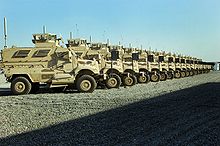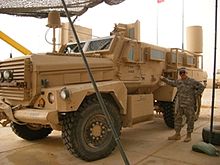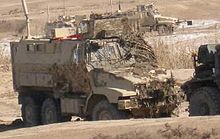- MRAP
-
For other uses, see MRAP (disambiguation).
MRAP 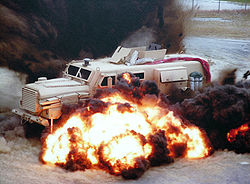
An MRAP Cougar HE in testing with land mines set off around it.Service history In service 2002–Present Specifications Weight 14+ tons A Mine Resistant Ambush Protected (MRAP; pronounced /ˈɛmræp/ em-rap) is a family of armored fighting vehicles design led by the United States Marine Corps in use by the United States Army, Navy, Air Force, and Special Operations Forces with the goal of surviving IED attacks and ambushes - prompted by US deaths in Iraq.[1] The first developments in armored vehicles designed specifically to counter the land mine threat took place during the 1972-1980 Rhodesian Bush War and the technology was subsequently matured in South Africa.[2]
Contents
General information
There is no common MRAP vehicle design; there are several vendors, each with a competing entry. Originally Brig. General Michael Brogan, and now Brig. General Frank Kelley, Commander, United States Marine Corps Systems Command, is in charge of the Marine MRAP program.[3][4] Mr. Kevin Fahey, U.S. Army Program Executive Officer for Command Support and Combat Service Support,[5] manages the Army MRAP program.[6] The Marine Corps had planned to replace all Humvees in combat zones with MRAP vehicles, although this appears to have changed.[7][8][9][10] As armored vehicles are considered an "urgent need" in Afghanistan, this program is primarily funded under an "emergency war budget". On 8 May 2007, Secretary of Defense Robert Gates stated that the acquisition of MRAPs are the Department of Defense's highest priority,[11] so for fiscal year 2007 US$1.1 billion is earmarked for MRAP .[12] Gates decided to ramp up MRAP orders after the Marines reported in 2004 that no troops had died in more than 300 IED attacks on Cougars [13] As of May 6, 2008 eight soldiers had been reported killed in the thousands of MRAPs in Iraq, according to news service Knight Ridder.[14]
In June 2008, USA Today reported that roadside bomb attacks and fatalities were down almost 90% partially due to MRAPs. "They've taken hits, many, many hits that would have killed soldiers and Marines in uparmored Humvees," according to Adm. Michael Mullen, chairman of the Joint Chiefs of Staff. Maj. General Rick Lynch, who commanded a division in Baghdad, told USA Today the 14-ton MRAPs have forced insurgents to build bigger, more sophisticated bombs to knock out the vehicles. Those bombs take more time and resources to build and set up, which gives U.S. forces a better chance of catching the insurgents in the act and stopping them.[15] The Taliban is also focusing their efforts away from anti-material IEDs and more toward smaller anti-personnel bombs meant to maim soldiers on patrol.[16]
This program is very similar to the US Army's Medium Mine Protected Vehicle program.[17]
Design
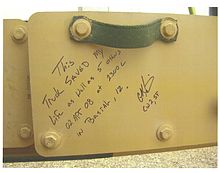 Writing on the door of an MRAP reads "This truck saved my life as well as 5 others on 02 Apr 08 at 2300 L in Basrah, IZ."
Writing on the door of an MRAP reads "This truck saved my life as well as 5 others on 02 Apr 08 at 2300 L in Basrah, IZ."
MRAP vehicles usually have "V" shaped hulls to deflect away any explosive forces originating below the vehicle, thereby protecting the vehicle and its passenger compartment[citation needed]. Typically these explosions are from land mines, but they can also be IEDs. This design dates to the 1970s when it was first introduced in 1978 with the South African Buffel (Buffalo) armored personnel carrier (APC)[citation needed]. However, the TSG/FPI Cougar (designed by a British-led US team in 2004 for a USMC requirement[citation needed]) became the springboard from which the MRAP program was launched.
Multiple contracts have been placed by the United States for this type of vehicle in response to the situation in the Iraq War. By issuing contracts to several companies, the Marine Corps hopes to accelerate the rate of production, in order to expedite the delivery of vehicles to deployed forces. However, there are only two steel mills in the United States, Oregon Steel Mills, Inc. and International Steel Group, qualified to produce armored steel for the Defense Department, which has been in negotiations to ensure enough steel is available to keep pace with production.[12] The concept is to replace Humvee type vehicles with a more robust, survivable vehicle when on patrol "outside the wire."
Designs were submitted by the following companies.
- Armor Holdings (acquired by BAE Systems on 31 July 2007)[18]
- BAE Systems
- Force Protection Inc (FPI)
- General Dynamics Land Systems (GDLS)
- General Purpose Vehicles (GPV)
- Navistar International Military Group (IMG)
- Oshkosh Truck
- Protected Vehicles Incorporated (PVI)
- Textron Marine and Land Systems
Although early orders were placed with many of the contenders (see below), as of 18 October 2007, only IMG, FPI, and BAE remain in the competition for additional orders.[19]
Orders
MRAP program
Just in 2007, US Military has ordered the production of about 10,000 MRAPs at a cost of over US$500,000 each, and planned to order more MRAPs. [20] Partial list of orders under the MRAP program:
- On 2007-01-30, FPI received an order for 2 Cougar H and 2 Cougar HE vehicles for testing and evaluation by the USMC for the MRAP program.[21]
- On 2007-02-14, the Marine Corps Systems Command placed a US$67.4 million delivery order for 65 Category I Cougar H, and 60 Category II Cougar HE vehicles,[22] as well as a US$55.4 million delivery order 15 Category I BAE RG-33 vehicles, and 75 Category II BAE RG-33L vehicles, built in York, Pennsylvania.
- On 2007-04-24, the Marine Corps Systems Command placed a USD $481.4 million order with Force Protection for 300 Category 1 Cougar H vehicles and 700 Category II Cougar HEs.[7]
- On 2007-05-31, the Marine Corps Systems Command ordered 1200 Category 1 International MaxxPros at a cost of $623M.[23]
- On 2007-06-01, FPI received an order for 14 Category III Buffalo vehicles from the Marine Corps Systems Command. The contract is worth an approximate US$11.9 million and is scheduled for completion by spring 2008.[21]
- On 2007-06-19, the Navy placed an order on behalf of the Marine Corps and Army for 395 Category 1, 60 Category 2 Force Protection Cougars at a cost of US$221 million, and for 16 Category 2 International MaxxPro XLs for the sum of US$8 million.[24]
- On 2007-06-28, amended 2007-07-16, BAE Systems received a US$235.8 million order for 16 RG-33 Category I patrol vehicles, 239 RG-33L Category II vehicles, 170 RG-33 Cat I variants for the United States Special Operations Command, out of their total allotment of 333 vehicles, and 16 RG-33L Category II Ambulance variants, which are the first vehicles in the competition specifically listed for the ambulance role.[25][26]
- On 2007-07-13, Stewart & Stevenson (Armor Holdings) received an order for 1,154 Category I and 16 Category II MRAP vehicles from the Marine Corps Systems Command. The vehicles are for delivery by February 2008 and the order is worth US$518.5 million.[27]
- On 2007-07-20, IMG received an additional order for 755 Cat I MaxxPro MRAP vehicles.[28]
- On 2007-08-06, General Dynamics Land Systems Canada received an order for 600 MRAP Cat II RG-31 vehicles. The contract is worth $338.7 million USD. Manufacturing will be done by the Demmer Corporation of Lansing, MI, in addition to BAE OMC of Benoni, South Africa. Deliveries will be completed by March, 2008.[29][30]
- On 2007-08-10, the Marine Corps Systems Command placed a USD $69.8m order with Force Protection for 25 Category 1 Cougar H vehicles and 100 Category II Cougar HEs.[31]
- On 2007-10-18, the Pentagon placed additional orders for one thousand Category I vehicles from IMG ($509M), 533 Category I and 247 Category II vehicles from Force Protection ($377M), and 399 standard Category II, 112 ambulance configured Category II RG-33L vehicles ($278M) from BAE Systems. BAE also received a separate $44M order for 89 RG33 Mod 5 (Category I) vehicles, for the US Special Operations Command. GDLS and Armor Holdings were informed that they will receive no further orders in the MRAP program.[19][32]
- On 2007-12-18, the US military placed its final orders of 2007. These went to Navistar for 1,500 Category I MaxxPros ($1.12B), BAE for 600 Category II vehicles ($645M), Armor Holdings (though BAE) for 668 Category II vehicles ($458M), and Force Protection for 178 Category I and 180 Category II Cougars ($378M).[33]
- On 2008-03-14, the US military placed its first orders of 2008. 1024 Category II Caiman's were ordered from BAE ($481.8M), 743 Category I MaxxPros were ordered from Navistar ($410.7M), and special command vehicles and ambulances were ordered from BAE ($234M).[34]
- On 2008-07-17, the US Marine Corps System Command placed an order with General Dynamics Land Systems Canada for 773 RG31 Category I MRAPs ($552M) for delivery by April 2009.[35]
2008 Information
- On 2008-01-02, Navistar Defense produced the 1,000th International MaxxPro Mine Resistant Ambush Protected (MRAP) vehicle.[36]
2009 Information
Oshkosh Corp., Oshkosh, Wis., is being awarded a $1,064,463,100 firm-fixed-priced delivery order under previously awarded firm-fixed-price contract W56HZV-09-D-0111 to exercise an option for 1,700 Mine Resistant Ambush Protected (MRAP) All Terrain Vehicles. The Navy contract value is $1,064,463,100. A similar Army contract for 1,700 Mine Resistant Ambush Protected (MRAP) All Terrain Vehicles is valued at a further $1,063,700,000.[37]
Parallel programs
Orders of vehicles associated with the MRAP program:
- On 2007-06-19 the US Army ordered an additional 44 BAE RG-31 Mk 5 vehicles and an additional 369 M1117 ASVs.[24]
Categories
The MRAP class is separated into three categories which describe the vehicle's weight class and size.
Category 1 (MRAP-MRUV)
The Mine Resistant Utility Vehicle (MRUV) is smaller and lighter, designed for urban operations.
Category 1 MRAP vehicles ordered or currently in service:
- BAE Caiman 4x4 - 2,800 ordered.[27][38][39]
- BAE OMC RG-31[40]
- BAE RG-33 4x4[41]
- Force Protection Cougar H 4x4 - 1,560 vehicles ordered.[7][42]
- International MaxxPro - 5,250 vehicles ordered.[23][43][44]
- Textron M1117 Guardian - Removed from competition. As of May 18, 2007, has been notified by the USMC that they will not be receiving any additional orders as part of the MRAP program.[45]
- Protected Vehicles Inc./Oshkosh Truck Alpha - Although 100 vehicles were initially ordered, Oshkosh was notified by the Marine Corps on June 29, 2007 that it would receive no further orders for the PVI Alpha due to "concern regarding overall vehicle survivability" and other fundamental design deficiencies of an automotive and ergonomic nature, adding that remediation "would require significant redesign".[46][47]
Category 2 (MRAP-JERRV)
The Joint Explosive Ordnance Disposal (EOD) Rapid Response Vehicle (JERRV) is designed for missions including convoy lead, troop transport, ambulance, explosive ordnance disposal and combat engineering.
Category 2 MRAP vehicles ordered or currently in service:
- Force Protection Cougar HE 6x6 - 950 vehicles ordered.[7]
- BAE RG-33L 6x6
- GDLS RG-31E - 600 vehicles ordered.[48]
- Oshkosh Truck/Thales Australia Bushmaster IMV - Has been removed from the competition as of 2007-08-07. According to a Thales press release, "The Thales Bushmaster vehicle offer for the US MRAP Phase 1 Program was not selected due to an evolving requirement, not due to a lack of marketing or lobbying effort…. Thales and Oshkosh remain confident of future potential sales of Bushmaster under ongoing Phases of MRAP in the US."[49]
- Protected Vehicles Inc Golan - 60 vehicles initially ordered, then when the Golan was eliminated from the competition all vehicles were discarded by the Marines.[50]
- International MaxxPro XL - 16 vehicles ordered.[51]
- BAE Caiman 6x6 - 16 vehicles ordered.[27]
Category 3
- Force Protection Buffalo MRV
- Dedicated mine/IED clearing function.
- Seating to carry 6 personnel.
Criticism
The deployment of MRAP vehicles has not been without criticisms. The most common are concerns about the high cost ($17.6 billion program), potential logistical difficulties due to high fuel consumption and varied designs, a greater disconnection between troops and the local population due to their massive size and menacing look (conflicting with current counter-insurgency (COIN) strategy), and what US Military will do with them following a US withdrawal from the current conflict in Iraq since they are expensive to transport and operate (some speculate they may be sold or donated to Iraq, or put in storage in America.)[52][53] MRAP funding has pulled money away from other tactical vehicle programs, most noticeably the Humvee replacement, the Joint Light Tactical Vehicle, which has been delayed by two years.[54]
According to Army Times, some troops openly wonder about the design of some versions of the MRAP. Some examples are: why the rear seats face inward and not outward in such a way they could fire their weapons through ports, which some versions lack. The height and steepness of the dropdown stairs at the rear of the some versions can make getting out of the vehicle dangerous. Troops riding in the rear can hit their head on the ceiling from bouncing up and down in rough terrain. Medics told the Army Times that a soldier broke his neck after bouncing his head off the overhead, and another is said to have seriously damaged his skull after slamming into a protruding bolt in the overhead while wearing a soft cover.[55]
The MRAP has been well received in the field, however, where soldiers are grateful for a vehicle designed around their needs and would much rather be hit by an IED in an MRAP than a Humvee.[56] [57]
Rollovers and Electric Shock
A June 13 report by the Marine Corps Center for Lessons Learned indicated concerns about MRAP vehicles rolling over in combat zones. The V-shaped hulls of the MRAP give it a higher center of gravity and the weight of the MRAP can cause the poorly built or maintained roads in rural Iraq or Afghanistan to collapse. Of the 66 MRAP accidents between November 7, 2007 and June 8, 2008, almost 40 were due to rollovers caused by bad roads, weak bridges, or driver error. In many of the rollovers troops were injured, and in two separate incidents five soldiers have been killed by rolling over into a canal and getting trapped under water. The report said 75% of all rollovers occurred in rural areas often when the road is above grade and a ditch or canal full of water is next to it. The same report raised concerns associated with MRAP vehicles snagging on low hanging powerlines in Iraq or its antennas getting close enough to create an electric arc, which may lead to electrocution of passengers. The person located in the gunner's hatch is at the highest risk.[55][58]
Effectiveness
The MRAP may not be effective against Explosively Formed Penetrators (EFP), which use an explosive charge to propel a specially shaped metal plate at high velocity while simultaneously deforming it into an armor-piercing projectile. Use of EFPs more than doubled in 2006 and is expected to continue to increase.[59] [60] In 2007, 11 percent of all roadside bomb fatalities were due to EFPs.[61] However, the Marines estimate that the use of the MRAP could reduce the casualties in Iraq due to IED attacks by as much as 80 percent.[62] The alleged MRAP weakness is being addressed by the next generation MRAP II. As an interim solution, the military is currently installing a variant of the Humvee's IED defeating Frag Kit 6 armor, which adds significant weight, as well as width to the already large and heavy vehicle.[4] In July 2008 the US Military reported the number of EFP attacks had dropped by 70 percent.[63]
On 2008-01-19 a 3rd Infantry Division U.S. Army soldier operating as the exposed turret gunner, was killed in a Navistar MaxxPro MRAP vehicle by an ANFO IED estimated at 600 lbs.[64] It is unknown whether the gunner was killed by the explosion or by the vehicle when it rolled over after the blast. However, the vehicle’s v-hull was not compromised. The crew compartment also appeared to be uncompromised in the attack, and the three other crew members who were all inside the vehicle survived; one with a shattered left foot, a broken nose and several broken teeth; one with a fractured foot; and the third unhurt.[64][65][66][67] Although this was reported as the first MRAP combat death, later reports clarified that several soldiers had been killed by IEDs in RG-31s and by EFPs in Buffalos before this incident.[68]
Logistics
Several criticisms of the MRAP program have been its lack of a common design, which presents a wartime logistical challenge, and the relatively few number of units which have been delivered to Iraq and Afghanistan, despite large orders.[4] However, some analysts see the diversity of MRAP vehicles as an advantage.[69] Other criticisms include the vehicle's weight and size, which severely limit its mobility off main roads, in urban areas, and over bridges.[70] 72 percent of the world's bridges cannot hold the MRAP.[71] Its heft also restricts several of the vehicles from being transported by C-130 cargo aircraft or the amphibious ships that carry Marine equipment and supplies. Although three MRAP vehicles (or five Oshkosh M-ATV's) will fit in a C-17 aircraft, airlifting is extremely expensive at $150,000 per vehicle, estimated by the U.S. Transportation Command.[72] In an effort to rush more vehicles to the theater, the U.S. Air Force even contracted several Ukrainian Antonov An-124 heavy cargo aircraft, which became a familiar sight in the skies above cities such as Charleston, South Carolina where some MRAPs are produced.[73] For comparison, sealifting costs around $13,000 per vehicle, but takes between three and four weeks for the vehicle to arrive in theater.[74] In December 2007, the Marine Corps reduced its request from 3700 vehicles to 2300.[10] The Army is also reassessing its MRAP requirements in Iraq.[75][76] In January 2010, 400 were flown in to Afghanistan, increasing to 500 a month in February, but the goal of 1,000 a month is delayed because of difficulty in distribution and training.[72]
MRAP II
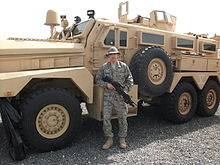 A member of the U.S. Air Force stands in front of an MRAP in Southwest Asia.
A member of the U.S. Air Force stands in front of an MRAP in Southwest Asia.
 External images
External images
Caimen MRAP vehicle [77] 
The Bull APC [78] On July 31, 2007, the Marine Corps Systems Command launched an MRAP II pre-solicitation, to develop a new vehicle that offers a higher level of protection than the current MRAP vehicles, particularly from advanced threats such as explosively formed penetrators.[79] While the Frag Kit 6 was designed to meet the threat of EFPs, the MRAP II competition's purpose was to find a vehicle that didn't need the upgrade kit. The U.S. Army Research laboratory worked to ensure the technologies used in Frag Kit 6 would be available to MRAP II designers.
In addition, the new solicitation was designed to provide the Joint Program Management Office with a greater flexibility to increase production capability and provide vehicles with enhanced protection and performance to meet future near-term requirements.[80] Full text of the solicitation can be found.[81]
The initial testing at the Aberdeen Proving Grounds served to disqualify vehicles that didn’t meet requirements. Competitors who did not receive MRAP-II orders include Force Dynamics (reinforced Cougar), GDLS Canada (upgraded BAE OMC RG-31), Navistar subsidiary IMG (upgraded MaxxPro), Textron's upgraded M1117, and Protected Vehicles, Inc. (upgraded Golan vehicle, with improved side doors and different armor; arrived on last day).[82] Blackwater USA (Grizzly APC with Ares EXO Scale appliqué armor) was later disqualified due to a limited amount of armor in the frontal area of the vehicle.
There were two eventual winners of the competition. The first was an upgraded Caiman, originally designed by Armor Holdings which was later acquired by BAE Systems. The second winner was the Bull, a combined effort between Ideal Innovations Inc, Ceradyne and Oshkosh. Both of the winning designs weighed 40,000 lbs or more.
According to the Army Times, the Pentagon has already decided to buy first-generation 14- to 24-ton MRAP Is with extra Frag Kit 6 derived armor, not the 30-ton MRAP IIs, when it places its final MRAP orders. Orders are expected at the end of summer in 2008 after a field commander's report on MRAP.[83] The Army Times also reported the Pentagon may also buy some shorter, lighter MRAPs in their final batch. A senior Pentagon official told them “The roads are caving in" under the weight of current MRAPS and "We want it to weigh less than it weighs now.”[84]
Plans to integrate developing technology
There currently are plans to integrate the Crows II remote weapon station, Raytheon Quick Kill active anti-RPG system, the Frag Kit 6 anti-EFP armor, and the Boomerang anti-sniper system on many MRAPs in combat.
MRAP M-ATV
On 30 June 2009, the Department of Defense announced that Oshkosh Defense had been awarded a production contract for 2,244 MRAP All Terrain Vehicles (M-ATV) to address the immediate need for vehicles in Afghanistan. In October 2009, the first M-ATV were shipped to Afghanistan.[85]
See also
- ATF Dingo
- AMZ Dzik
- AMZ Tur
- Buffalo
- Buffel
- Bushmaster IMV
- Bull
- Caiman
- Cheetah
- Cougar
- Grizzly APC
- Humvee
- M-ATV
- Matador
- Marauder
- MaxxPro
- RG-33
- Unibuffel
References
- ^ More Attacks, Mounting Casualties, Washington Post
- ^ Russell, Robert W (2009). Does the MRAP meet the US Army's needs as the primary method of protecting troops from the IED threat? (Master of Military Art and Science thesis). US Army Command and General Staff College. http://www.dtic.mil/dtic/tr/fulltext/u2/a502075.pdf.
- ^ http://www.dla.mil/DLAPublic/DLA_Media_Center/TopStories.aspx?ID=645
- ^ a b c Defense Tech: Frag Kit 6 to go on MRAPs
- ^ http://peocscss.tacom.army.mil/docs/BIO%20-%20CS&CSS%20Fahey.pdf
- ^ http://peocscss.tacom.army.mil/org.html
- ^ a b c d "MRAP Vehicle Order: 1,000 Cougars to be Turned Loose." Defense Industry Daily. 25 Apr 2007.
- ^ Marines Urge Caution on MRAP Fielding
- ^ Another Casualty of the Surge
- ^ a b Armored Vehicle Cut Threatens Industry
- ^ USA Today. http://www.usatoday.com/news/graphics/ied-deaths/flash.htm?tabNum=tab1. Retrieved 2010-05-13.
- ^ a b Surge in vehicle orders calls for unconventional buying methods
- ^ The truck the Pentagon wants and the firm that makes it - USATODAY.com
- ^ Military.com Article
- ^ Roadside bombs decline in Iraq - USATODAY.com
- ^ Dan Lamothe (9). "New weapons, war dogs eyed to fight IEDs". Gannett Government Media Corporation. http://www.marinecorpstimes.com/news/2011/05/marine-corps-ied-afghanistan-george-flynn-050911w/. Retrieved 9 May 2011.
- ^ US Army: 17,000 MRAP Vehicles to Replace Hummers? Defense Industry Daily. 11 May 2007.
- ^ "BAE Systems completes acquisition of Armor Holdings Inc." (PDF) (Press release). BAE Systems plc. 2007-07-31. http://www.baesystems.com/Newsroom/NewsReleases/autoGen_107631191035.html. Retrieved 2008-08-06.
- ^ a b Borak, Donna. "Pentagon orders 2,400 armored vehicles". Archived from the original on 2007-11-11. http://web.archive.org/web/20071111055805/http://www.businessweek.com/ap/financialnews/D8SBU09O0.htm.
- ^ Eisler, Peter (2007-10-02). "The truck the Pentagon wants and the firm that makes it". USA Today. http://www.usatoday.com/news/military/2007-08-01-force-protection-mraps_N.htm. Retrieved 2010-05-13.
- ^ a b Force Protection, Inc. - In the News
- ^ MRAP: Survivable Rides, Start Rolling
- ^ a b DefenseLink: Contracts for Thursday, May 31, 2007
- ^ a b USMC, Army Release Orders for more than 2500 Armored Vehicles
- ^ "BAE's Diverse MRAP Orders." Defense Industry Daily. 13 Nov 2007.
- ^ "BAE's Diverse MRAP Orders." Defense Industry Daily. 13 Nov 2007.
- ^ a b c ""MRAP Orders Approach 5,000". Archived from the original on 2008-02-05. http://web.archive.org/web/20080205114628/http://www.marines.mil/marinelink/mcn2000.nsf/0/392158BE6C6E5AE9852573170073B9C4?opendocument.." marines.mil July 13, 2007.
- ^ More MRAPs: Navistar’s MaxxPro Maintains the Pole Position - Defense Industry Daily
- ^ General Dynamics News - August 8, 2007
- ^ General Dynamics Wins MRAP Orders of Its Own - Defense Industry Daily
- ^ "Cougar Armored Trucks to Stalk Mines on the Battlefield (updated)." Defense Industry Daily. 12 Nov 2007.
- ^ USMC Releases New Orders for 2,288 MRAPs
- ^ TheStreet.com : Navistar Wins Big MRAP Order | Aerospace/Defense | FRPT NAVZ
- ^ [1][dead link]
- ^ General Dynamics to Supply 773 RG-31 MRAP Vehicles to U.S. Defense Department
- ^ News
- ^ Militaryindustrialcomplex.com Defense Contracts Listing for 7/31/2009
- ^ Armor Holdings, Inc. Receives $518 Million MRAP Award
- ^ DefenseNews.com - U.S. Marines Order 1,170 MRAPs - 07/13/07 18:55
- ^ "MRAP Advance Purchase #2: Oshkosh, PVI & GD." Defense Industry Daily. 06 Mar 2007.
- ^ MRAP: Survivable Rides, Start Rolling
- ^ Cougar Armored Trucks to Stalk Mines on the Battlefield (updated). Defense Industry Daily. 12 Nov 2007.
- ^ DefenseNews.com - U.S. Orders 1,200 MRAPs - 05/31/07 12:56
- ^ DefenseNews.com - DoD Orders 2,400 MRAPs from 3 Firms - 10/18/07 20:23
- ^ "Textron's M1117 Removed from MRAP Competition." Defense Industry Daily. 18 May 2007.
- ^ Pentagon rejects Oshkosh’s truck design | Business | Rhode Island news | projo.com | The Providence Journal
- ^ MRAP: Another One Bites the Dust? - Defense Industry Daily
- ^ General Dynamics News - August 8, 2007
- ^ MRAP: Oshkosh Entries Stalled on 2 Fronts - Defense Industry Daily
- ^ MRAPs on the march - Jane's Land Forces News
- ^ U.S. Marine Corps Awards $8.5 Million Contract for Category II Mine-Resistant Ambush Protected (MRAP) Vehicles to International Military and Government, LLC.
- ^ Defense Tech: Corps Asks for MRAP Slowdown
- ^ Andrew Krepinevich and Dakota Wood. Of IEDs and MRAPs: Force Protection In Complex Irregular Operations."
- ^ InsideDefense.com NewsStand: The Insider
- ^ a b Mitchell, Bryan; Andrew Scutro, Kris Osborn (July 3, 2008). "SF deaths come amid MRAP rollover concerns: Three soldiers drowned after RG-31 rolled into canal in Afghanistan". http://www.armytimes.com/news/2008/07/marines_MRAP_070108w/.
- ^ The 2d Cavalry Assn News Center » A new age in troop protection
- ^ Vanden Brook, Tom (2007-12-16). "Long-term needs lessen, but vehicles still sought". USA Today. http://www.usatoday.com/news/military/2007-12-16-MRAP_N.htm. Retrieved 2008-08-03.
- ^ Associated Press: Fatal MRAP accidents prompt warnings
- ^ Bryce, Robert (2007-01-22). "Surge of danger for U.S. troops". Salon.com. http://www.salon.com/news/feature/2007/01/22/ieds/index.html. Retrieved 2008-08-03.
- ^ Vanden Brook, Tom (2007-05-31). "MRAPs can't stop newest weapon". USA Today. http://www.usatoday.com/news/world/iraq/2007-05-31-mrap-insurgents_N.htm. Retrieved 2008-08-03.
- ^ Weapons: Dealing With EFPs
- ^ "Biden MRAP Amendment Speech" (DOC). http://www.defenseindustrydaily.com/files/2007-03-28_Biden_MRAP_Amendment_Speech.doc.
- ^ Michaels, Jim (July 18, 2008). "EFPs in Iraq drop 70 percent in 3 months". Army Times. http://www.armytimes.com/news/2008/07/gns_efp_071708/.
- ^ a b TURNER, KEVIN (2008-02-02). "Army's new protective vehicle saved soldier's life in Iraq". The Florida Times-Union (Jacksonville.com). http://jacksonville.com/tu-online/stories/020208/met_242926844.shtml.
- ^ Farrell, Stephen (2008-01-22). "Hopes for Vehicle Questioned After Iraq Blast". The New York Times. http://www.nytimes.com/2008/01/22/world/middleeast/22vehicle.html?pagewanted=1&_r=1&ei=5088&en=147b65d317fbd6fe&ex=1358658000&partner=rssnyt&emc=rss. Retrieved 2010-05-13.
- ^ Tait, Paul (2008-01-22). "US suffers first death in new armoured truck". Reuters. http://www.reuters.com/article/latestCrisis/idUSL22400735.
- ^ Hopes for NY Times Reporting Questioned After MRAP Story - Defense Industry Daily
- ^ Weekly Standard: MRAP Confusion
- ^ Diversity Adds Depth to MRAP
- ^ Armored Vehicle Cut Threatens Industry
- ^ Washington Pulse
- ^ a b http://www.strategypage.com/htmw/htlog/20100322.aspx
- ^ USAF Hires Russian Jets
- ^ Army.com - Sealift of MRAP vehicles begins
- ^ General: Army Will Need Fewer MRAPs
- ^ Vanden Brook, Tom (2007-12-19). "Military sets sights on at least 15,000 MRAPs". USA Today. http://www.usatoday.com/news/military/2007-12-19-mraps_N.htm. Retrieved 2008-08-03.
- ^ Army Recognition :: View topic - CAIMAN MRAP vehicle from BAE North America
- ^ Ideal Innovations, Inc. - News Archive
- ^ USA Issues MRAP-II Solicitation - Defense Industry Daily
- ^ Marine Corps Systems Command Launches MRAP II Solicitation
- ^ FILE | 23 | Mine Resistant Ambush Protected Vehicles (MRAP) II Enhanced Vehicle Competitive | 02-Aug-07 - FBO#2075
- ^ EFP Mines? Ceradyne & i3 Say “Bull!”
- ^ http://www.armytimes.com/news/2008/07/defense_MRAP_II_070308/
- ^ Pentagon may buy shorter, lighter MRAPs - Army News, opinions, editorials, news from Iraq, photos, reports - Army Times
- ^ http://news.cnet.com/8301-11386_3-10365288-76.html
External links
- Associated Press article about MRAPs in Iraq (9 May 2008)
- "United States Marine Corps article". Archived from the original on 2006-02-28. http://web.archive.org/web/20060228180439/http://www.usmc.mil/marinelink/mcn2000.nsf/0/E4885590CF8E34DB8525702A007DAB4F?opendocument.
- Global Security
- Billions Needed for New Armored Trucks
- Blast Resistant vs Armored
- MRAP - on Defense Update.com
- International Trucks/Plasan Sasa MRAP
- Pentagon balked at pleas from officers in field for safer vehicles (USA Today 7-16-07)
- Troops receive their first MaxxPro MRAPs in Iraq (video)
- Study Faults Delay of Armored Trucks for Iraq
- Video of an MRAP vehicle rolling over in Iraq. The edge of the road gave way on a hill.
- Austrian Armored MRAP design.
Categories:- Wheeled armored fighting vehicles
- Wheeled armoured personnel carriers
- Military engineering vehicles
- Modern military vehicles
Wikimedia Foundation. 2010.

